THE LIVING TAO : TIMELESS WISDOM FOR THE MODERN WORLD
This is a podcast dedicated to exploring the profound, yet elusive True Tao (真道). Acknowledging that the essence of Tao is beyond traditional discourse and expression, this series seeks to demystify Taoist principles and adapt them for contemporary listeners. Each episode offers a blend of ancient wisdom and modern insights, providing practical guidance for navigating the complexities of today’s world. Whether you’re a seasoned practitioner or new to the path, join us in discovering how the timeless wisdom of Tao can be lived out in the here and now.
Episodes
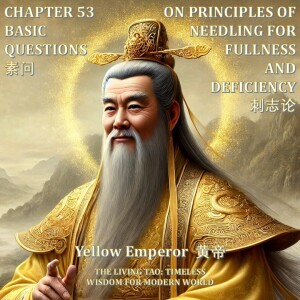
Monday Nov 25, 2024
Monday Nov 25, 2024
The Yellow Emperor's Classic of Internal Medicine, specifically Chapter 53, explores the principles of acupuncture based on the concepts of fullness and deficiency in the body. Qi Bo, a renowned physician, explains that imbalances, such as having abundant energy yet feeling cold, or low energy with warmth, signify illness. These imbalances are linked to various factors including diet, exposure to weather, and internal conditions. The text details how to diagnose these conditions through pulse and other observations. Finally, it describes acupuncture techniques—opening or closing points with the left hand—for treating fullness and deficiency, respectively, to restore balance.
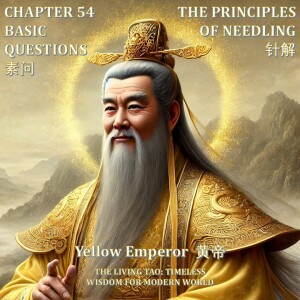
Monday Nov 25, 2024
Monday Nov 25, 2024
This Chapter is a dialogue from the Yellow Emperor's Classic of Internal Medicine, exploring the principles of acupuncture's Nine Needles. Qi Bo, explaining to the Yellow Emperor, details how these needles treat imbalances of yin and yang by addressing fullness and deficiency in the body. The techniques described involve precise needle insertion and manipulation, timed to align with the body's energy flow. Specific acupuncture points are identified, and the broader philosophical context links the practice to the cosmos, emphasizing the interconnectedness between human physiology and the natural world. Ultimately, the text aims to codify acupuncture techniques for future practitioners.
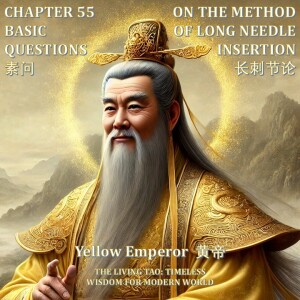
Monday Nov 25, 2024
Monday Nov 25, 2024
The Yellow Emperor's Classic of Internal Medicine, Chapter 55, details acupuncture techniques for various ailments. The text describes specific needle insertion methods for conditions affecting the head, abdomen, tendons, muscles, bones, and the overall energy flow (Qi). It emphasizes the importance of accurate needle placement to avoid damaging tissues while achieving therapeutic warmth. Different approaches are outlined based on the location and nature of the illness, such as treating cold and heat imbalances or addressing deep-seated pain. The chapter concludes with treatments for recurring illnesses and severe conditions like "great wind."
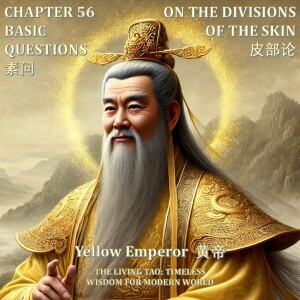
Monday Nov 25, 2024
Monday Nov 25, 2024
This Chapter from The Yellow Emperor’s Classic of Internal Medicine details the relationship between the skin and the body’s meridians. It describes twelve distinct skin regions, each connected to a specific meridian, explaining how illness begins in the skin and progresses through the network vessels and meridians to the internal organs. The text emphasizes the diagnostic importance of skin color and texture changes in relation to meridian imbalances and the resulting diseases. A dialogue between the Yellow Emperor and Qi Bo reveals a system of understanding illness based on the flow of energy through the body's channels. The condition of the skin provides essential clues to identifying and treating disease.
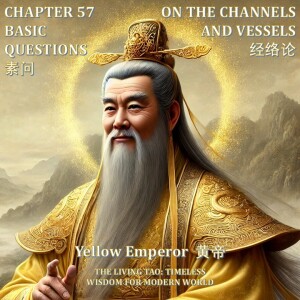
Monday Nov 25, 2024
Monday Nov 25, 2024
This Chapter is a dialogue from Chapter 57 of the Yellow Emperor's Classic of Internal Medicine, focusing on the colors of channels and vessels in the body. The Yellow Emperor questions Qi Bo, a renowned physician, about the varying colors observed in these vessels. Qi Bo explains that the channels have consistent colors associated with specific organs (heart-red, lungs-white, etc.), while the vessels' colors change depending on the season and the presence of cold or heat. Yin vessels reflect their corresponding organ color, but yang vessels show variable hues reflecting the body's condition. The appearance of all five colors together signifies an imbalance of both cold and heat.
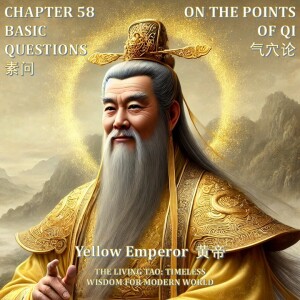
Monday Nov 25, 2024
Monday Nov 25, 2024
The Yellow Emperor's Classic of Internal Medicine, Chapter 58, details a dialogue between the Yellow Emperor and Qi Bo concerning 365 qi points in the human body. These points, corresponding to the days of the year, are categorized by organ, function, and location, with specific points detailed for various ailments. The discussion also expands to encompass collateral vessels and convergence points, which are equally vital for regulating qi and preventing disease. Qi Bo emphasizes the importance of these points in maintaining health and treating illness through acupuncture. The Emperor ultimately enshrines this medical knowledge for safekeeping.
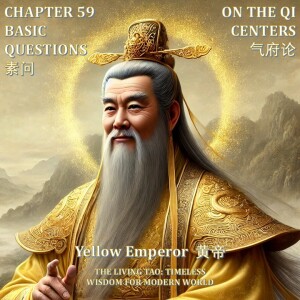
Monday Nov 25, 2024
Monday Nov 25, 2024
This Chapter from the Yellow Emperor's Classic of Internal Medicine details the locations of acupuncture points along the body's twelve main meridians, including the Du and Ren meridians. The text meticulously lists the number and precise anatomical positions of these points for each meridian. Each meridian's point distribution is described, with a total of 365 points noted, reflecting the number of days in a year. The significance of this mapping relates to traditional Chinese medicine's understanding of Qi flow and energy balance within the human body. The text also includes details on key points associated with specific organ systems.
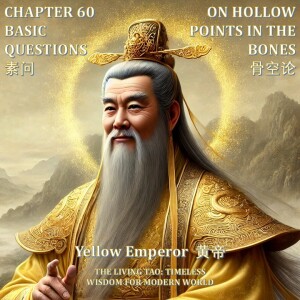
Monday Nov 25, 2024
Monday Nov 25, 2024
This Chapter is an excerpt from the Yellow Emperor's Classic of Internal Medicine, specifically Chapter 60, "On Hollow Points in the Bones." It details a dialogue between the Yellow Emperor and Qi Bo concerning the treatment of ailments believed to originate from wind. The discussion covers various acupuncture points and moxibustion techniques to address pain, swelling, and other conditions related to the meridians and bone structure. Specific points on the Ren, Chong, and Du meridians are identified, along with their associated symptoms and treatments. The text also describes locations of "hollow points in the bones" and provides a step-by-step moxibustion procedure.
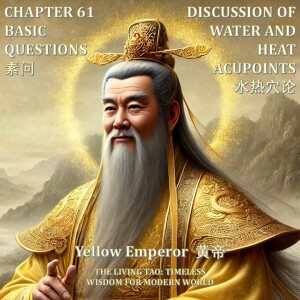
Monday Nov 25, 2024
Monday Nov 25, 2024
This Chapter is a dialogue from the Yellow Emperor's Classic of Internal Medicine, exploring the relationship between the kidneys, water, and disease within the framework of Traditional Chinese Medicine. It discusses the kidneys' role in water metabolism, explaining how imbalances lead to conditions like edema. The dialogue further details seasonal acupuncture principles, suggesting different treatment strategies based on the interplay of the five elements and the body's energetic flow. Finally, it describes specific acupoints used to address water and heat-related disorders.
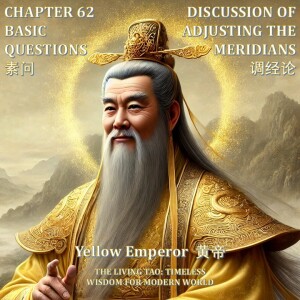
Monday Nov 25, 2024
Monday Nov 25, 2024
This Chapter is a dialogue from the Yellow Emperor’s Classic of Internal Medicine, specifically Chapter 62, focusing on acupuncture principles. The Emperor and Qibo discuss the concepts of excess and deficiency in the body’s five elements (spirit, qi, blood, form, and will), their causes, symptoms, and acupuncture treatments. They explore the origins of imbalances in the five organs and meridians, emphasizing the importance of harmonizing blood and qi flow. Detailed acupuncture techniques, including subtle needling and consideration of yin and yang, are described to restore balance and resolve illnesses. Finally, the relationship between the five organs, twelve meridians, and the application of acupuncture is explained.

The Living Tao
Welcome to The Living Tao: Timeless Wisdom for the Modern World—your guide to living a life of balance, wisdom, and inner peace. Inspired by the profound teachings of ancient masters, this podcast explores the enduring relevance of these timeless insights in today’s fast-paced world.
Taoist teachings emphasize living in harmony with the natural flow of life—the Tao, or "the Way." This philosophy invites us to embrace simplicity, cultivate humility, and find peace by aligning ourselves with the rhythms of the universe. At its heart, Taoism encourages us to let go of resistance, shed the distractions of ego, and discover the profound serenity that comes from living authentically and in tune with our true nature.
The Tao Te Ching, attributed to Laozi, is one of the most influential texts in Taoism and serves as a cornerstone of our discussions. Its poetic verses guide us to reflect on themes like balance, self-awareness, and effortless action, or wu wei. These teachings are not bound by time or culture—they resonate just as powerfully today, offering insights that help us navigate the complexities of modern life with grace and equanimity.
Each episode of The Living Tao will uncover practical wisdom rooted in these ancient teachings, presenting it in ways that are both accessible and transformative. Whether it's understanding the art of stillness in a world of constant movement, finding clarity amid chaos, or exploring the paradoxes of strength through softness, you’ll discover tools and perspectives to enrich your life and deepen your connection to the world around you.
Whether you're a seasoned practitioner familiar with the Taoist path or a newcomer drawn to its gentle yet profound philosophy, this podcast offers something for everyone. Together, we'll explore how these age-old principles can help us embrace change, cultivate mindfulness, and find a sense of purpose and inner peace in the face of life's challenges.
Join us on this journey of self-discovery, as we bring the wisdom of the Tao into the present moment. Let the timeless truths of this ancient tradition inspire and empower you to live a more harmonious and enlightened life. Tune in, reflect, and allow the teachings of The Living Tao to guide you back to the essence of who you are.








